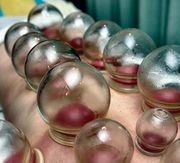Cupping
Cupping involves the suctioning of a cup to one's skin, increasing blood flow to the area
The suction from this vacuum pulls the skin into glass and is strong enough to hold the glass into place even when the subject stands. The larger the glass, the stronger the vacuum.
Methods include:
- Wiping alcohol directly on the skin, igniting it, and then quickly placing the cup over the area (frequently criticized as having a higher risk of burning the skin and greater difficulty creating/controlling suction);
- Holding the cup over an open flame until it is warm and then applying it to cool skin (some people feel this is the safest - though some feel that heating the glass (rather than the air) causes room for additional danger. This is also the hardest method to beginners wishing to create a strong suction);
- Placing small disks with cotton balls soaked in alcohol on them onto the skin. The cotton is then ignited and a cup is placed over the disk. (In theory the leather shield protects the skin, but the method is sometimes criticized as too complicated and more likely to burn to skin when performed inexpertly.)
- Applying fuel directly inside the cup - the cup is then usually put on the skin with the fuel still burning (the flame will quickly extinguish from want of oxygen).
Cupping typically leaves small, round marks on the body that may last for hours or for days. If a single area is cupped again and again, a deep bruise may form and not disappear for some time.
It is often combined with blood play, and is then usually termed blood- or wet-cupping. (This variant also comes from traditional medicine). The skin is pierced (commonly with needles or scalpels) before the cups are applied; the suction then draws blood out of the wound.
See also
External links
| This page uses content from Kinkipedia (see here); the original article may be viewed here. |
